Submitted:
22 November 2023
Posted:
23 November 2023
You are already at the latest version
Abstract
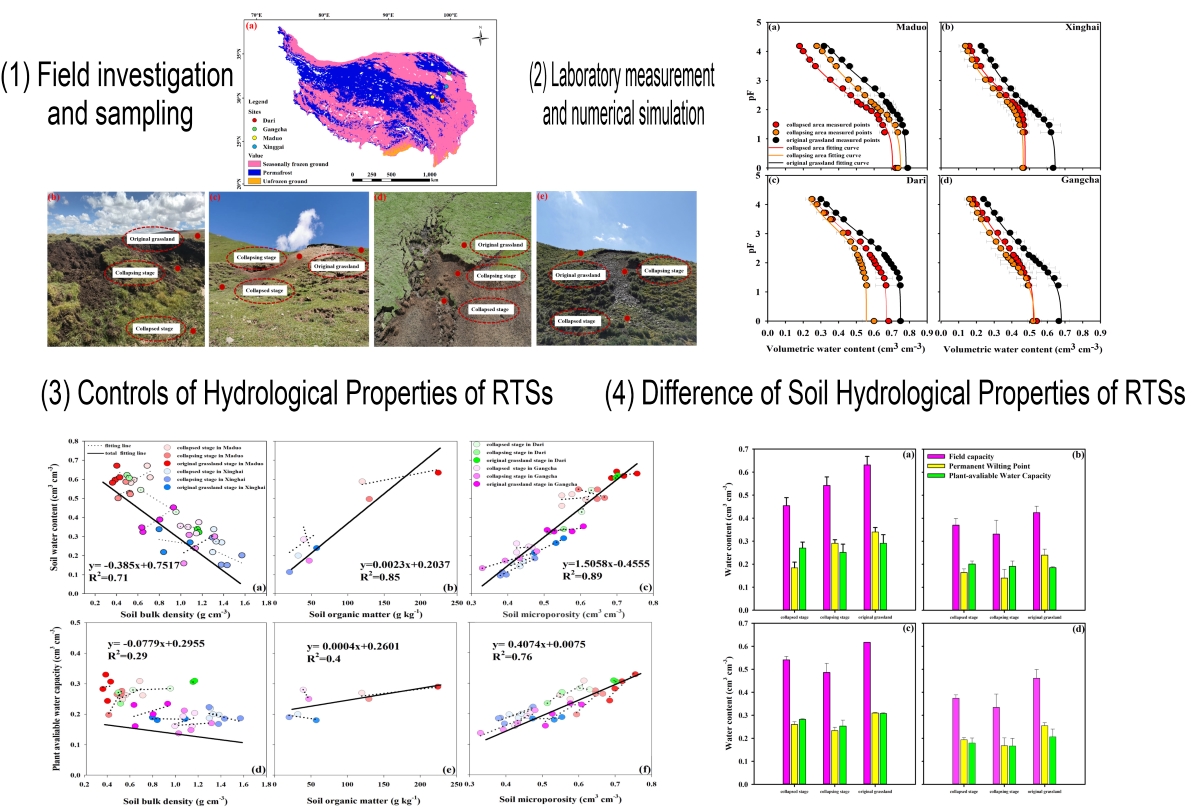
Keywords:
1. Introduction
2. Methods
2.1. Study area and field investigation
2.2. Measurement of soil water retention curves and related physical properties
2.3. Simulation of soil water retention curves with associated soil hydraulic properties
2.4. Evaluation of simulation performances
3. Results
3.1. Observed soil hydraulic properties changes in different freeze-thaw slump stages
3.2. Simulation of soil water retention curves and associated soil hydrological properity
3.3. Plant available water, soil water storage and plant available water storage changes across thaw slump stages
3.4. Relations of soil water retention and content with soil hydraulic properties
4. Discussion
4.1. Effects of the freeze-thaw cycle on soil water retention across thaw slump stages
4.2. Effects of RTSs on soil structure over the three freeze-thaw stages
4.3. Controls of differences in soil water retention and water content for RTSs
5. Conclusions
Acknowledgments
References
- Bowden, W.B.; Gooseff, M.N.; Balser, A.; Green, A.; Peterson, B.J.; Bradford, J. Sediment and nutrient delivery from thermokarst features in the foothills of the North Slope, Alaska: potential impacts on headwater stream systems. J. Geophys. Res. Biogeosci. 2008, 113, G02026. [Google Scholar] [CrossRef]
- Olefeldt, D.; Goswami, S.; Grosse, G.; Hayes, D.; Hugelius, G.; Kuhry, P.; McGuire, A.D.; Romanovsky, V.; Sannel, A.B.K.; Schuur, E.; Turetsky, M.R. Circumpolar distribution and carbon storage of thermokarst landscapes. Nat. Commun. 2016, 7, 13043. [Google Scholar] [CrossRef]
- Lewkowicz, A.G.; Way, R.G. Extremes of summer climate trigger thousands of thermokarst landslides in a High Arctic environment. Nat. Commun. 2019, 10, 1329. [Google Scholar] [CrossRef]
- Burn, C.R.; Lewkowicz, A.G. Canadian Landform Examples -17: Retrogressive thaw slumps. Can. Geogr. 1990, 34, 273–276. [Google Scholar] [CrossRef]
- Burn, C.R.; Kokelj, S.V. The permafrost and environment of the Mackenzie Delta area. Permafr. Periglac. Process. 2009, 20, 83–105. [Google Scholar] [CrossRef]
- Lewkowicz, A.G. Dynamics of active-layer detachment failures, Fosheim Peninsula, Ellesmere Island, Nunavut, Canada. Permafr. Periglac. Process. 2007, 18, 89–103. [Google Scholar] [CrossRef]
- Kokelj, S.V.; Jorgenson, M.T. Advances in thermokarst research. Permafr. Periglac. Process. 2013, 24, 108–119. [Google Scholar] [CrossRef]
- Cheng, G.D. Problems on zonation of high-altitude permafrost. Acta Geogr Sin. 1984, 39, 185–193. [Google Scholar]
- Luo, J.; Niu, F.J.; Lin, Z.J.; Liu, M.H.; Yin, G.A. Recent acceleration of thaw slumping in permafrost terrain of Qinghai–Tibet Plateau: an example from the Beiluhe Region. Geomorphology. 2019, 341, 79–85. [Google Scholar] [CrossRef]
- Luo, J. , Niu, F. J.; Lin, Z.J.; Liu, M.H.; Yin, G.A.; Gao, Z.Y.; Inventory and frequency of retrogressive thaw slumps in permafrost region of the Qinghai–Tibet Plateau. Geophys. Res. Lett. 2022, 49, 23, e2022GL099829. [Google Scholar] [CrossRef]
- Lewkowicz, A.G. Headwall retreat of ground-ice slumps, Banks Island, Northwest Territories. Can J Earth Sci. 1987, 24, 1077–1085. [Google Scholar] [CrossRef]
- Lacelle, D.; Brooker, A.; Fraser, R.H.; Kokelj, S.V. Distribution and growth of thaw slumps in the RichardsonMountains–Peel Plateau region, northwestern Canada. Geomorphology. 2015, 235, 40–51. [Google Scholar] [CrossRef]
- Kokelj, S.V.; Tunnicliffe, J.; Lacelle, D.; Lantz, T.C.; Chin, K.S.; Fraser, R. Increased precipitation drives mega slump development and destabilization of ice-rich permafrost terrain, northwestern Canada. Global Planet Change. 2015, 129, 56–68. [Google Scholar] [CrossRef]
- Burn, C. R. The thermal regime of a retrogressive thaw slump near Mayo, Yukon Territory. Can. J. Earth Sci. 2000, 37, 967–981. [Google Scholar] [CrossRef]
- Lantuit, H.; PollardW, H. Fifty years of coastal erosion and retrogressive thaw slump activity on Herschel Island, southernBeaufort Sea, Yukon Territory, Canada. Geomorphology. 2008, 95, 84102. [Google Scholar] [CrossRef]
- Lantz, T.C.; Kokelj, S.V. Increasing rates of retrogressive thaw slump activity in the Mackenzie Delta region, N.W.T., Canada. Geophys. Res. Lett. 2008, 35, L06502. [Google Scholar] [CrossRef]
- Kokelj, S.V.; Lantz, T.C.; Kanigan, J.; Smith, S.L.; Coutts, R. Origin and polycyclic behaviour of tundra thaw slumps, Mackenzie Delta region, Northwest Territories, Canada. Permafr. Periglac. Process. 2009, 20, 173–184. [Google Scholar] [CrossRef]
- Robinson, S. D. Thaw-slump-derived thermokarst near Hot Weather Creek, Ellesmere Island, Nunavut. In M. Garneau & B. T. Alt (Eds.), Environmental response to climate change in the Canadian high Arctic (2000, 529, 335–345). Geological Survey of Canada.
- Jorgenson, M.T.; Osterkamp, T.E. 2005 Response of boreal ecosystems to varying modes of permafrost degradation. Can J Forest Res. 35, 2100–2111. [CrossRef]
- Segal, R.A.; Lantz, T.C.; Kokelj, S.V. 2016 Acceleration of thaw slump activity in glaciated landscapes of the Western Canadian Arctic. Environ. Res. Lett. 2016, 11, 034025. [Google Scholar] [CrossRef]
- Katamura, F.; Fukuda, M.; Bosikov, N.P.; Desyatkin, R.V.; Nakamura, T.; Moriizumi, J. Thermokarst formation and vegetation dynamics inferred from a palynological study in central Yakutia, eastern Siberia. Arct. Antarct. Alp. Res. 2006, 38, 561–570. [Google Scholar] [CrossRef]
- Jiang, G.L.; Gao, S.R.; Lewkowicz, A.G.; Zhao, H.; Pang, S.J.; Wu, Q.B. ; Development of a rapid active layer detachment slide in the Feng huo shan Mountains, Qinghai–Tibet Plateau. Permafr. Periglac. Process. 2022, 33, 298–309. [Google Scholar] [CrossRef]
- Lu X.Y.; Kelsey, K.C.; Yan, Y, Sun, J.; Wang, X.D.; Cheng, G.W.; Neff, J.C . Effects of grazing on ecosystem structure and function of alpine grasslands in Qinghai-Tibetan Plateau: a synthesis. Ecosphere. 2017, 8, e01656. [CrossRef]
- Dai, L.C.; Yuan, Y.M.; Guo, X.W.; Du, Y.G.; Ke, X.; Zhang, F.W.; Li, Y.K.; Li, Q.; Lin, L.; Zhou, H.K.; Cao, G.M. Soil water retention in alpine meadows under different degradation stages on the northeastern Qinghai-Tibet Plateau. J. Hydrol. 2020, 590, 125397. [Google Scholar] [CrossRef]
- Sun, Y.; Wang, Y.B; Yang, W.J.; Sun, Z.; Zhao, J.P. 2019 Variation in soil hydrological properties on shady and sunny slopes in the permafrost region. Qinghai-Tibetan Plateau. Environ. Earth Sci. 2019, 78, 100. [Google Scholar] [CrossRef]
- Wu, G.L.; Huang, Z.; Liu, Y.F.; Cui, Z.; Liu, Y.; Chang, X.F.; Tian, F.P.; Lopez-Vicente, M.; Shi, Z.H. Soil water response of plant functional groups along an artificial legume grassland succession under semi-arid conditions. Agric. For. Meteorol. 2019, 278, 107670. [Google Scholar] [CrossRef]
- Pan, T, Hou, S, Wu, S. H.; Liu, Y.H.; Liu, Y.H.; Zou, X.; Herzberger, A.J.; Liu, J.G. Variation of soil hydraulic properties with alpine grassland degradation in the eastern Tibetan Plateau. Hydrol. Earth Syst. Sci. 2017, 21, 2249–2261. [CrossRef]
- Wei, Q.; Wang, F.; Chen, W.Y.; Zhu, L.; Li, G.Y.; Qi, D.C. Soil physical characteristics on different degraded alpine grasslands in Maqu county in upper Yellow River, Bull. Soil Water Conserv. 30, 16–21, 2010.
- Wösten, J.; Pachepsky, Y.A.; Rawls, W. Pedotransfer functions: bridging the gap between available basic soil data and missing soil hydraulic characteristics J. Hydrol. 2001, 251, 123–150. [Google Scholar] [CrossRef]
- Dong, S.K.; Shang, Z.H.; Gao, J.X. ; Boone R B 2020 Enhancing sustainability of grassland ecosystems through ecological restoration and grazing management in an era of climate change on Qinghai-Tibetan Plateau. Agr Ecosyst Environ. 2020, 287, 106684. [Google Scholar] [CrossRef]
- Xu, H.Y.; Liu, G.; Wu, X.; Smoak, J.M.; Mu, C.C.; Ma, X.L.; Zhang, X.L.; Li, H.Q.; Hu, G.L. Soil enzyme response to permafrost collapse in the Northern Qinghai-Tibetan Platea. Ecol. Indic. 2018, 85 585–593. [CrossRef]
- Mu, C.C.; Zhang, T.J.; Zhang, X.K.; Li, L.L.; Guo, H.; Zhao, Q.; Cao, L.; Wu, Q.B.; Cheng, G.D. 2016 Carbon loss and chemical changes from permafrost collapse in the northern Tibetan Plateau. J. Geophys. Res. Biogeosci. 2016, 121, 1781–1791. [Google Scholar] [CrossRef]
- Gao, Z.; Hu, X.; Li, X.Y. Changes in soil water retention and content during shrub encroachment process in inner Mongolia, northern China. Catena, 2021, 206, 105528. [Google Scholar] [CrossRef]
- Ma, Q.H.; Zhang, K.L.; Jabro, J.D.; Ren, L.; Liu, H.Y. Freeze-thaw cycles effects on soil physical properties under different degraded conditions in Northeast China. Environ Earth Sci. 2019, 78, 1–12. [Google Scholar] [CrossRef]
- Lin, J.G.; Zou, W.L.; Han, Z.; Zhang, Z.W.; Wang, X.Q. Structural, volumetric and water retention behaviors of a compacted clay. J. Rock Mech. Geotech. Eng. 2022, 14, 953–966. [Google Scholar] [CrossRef]
- Dai, L.C.; Guo, X.W.; Ke, X.; Du, Y.G.; Zhang, F.W.; Cao, G.M. The variation in soil water retention of alpine shrub meadow under different degrees of degradation on northeastern Qinghai-Tibetan plateau. Plant Soil. 2021, 458, 231–244. [Google Scholar] [CrossRef]
- Van Genuchten, M.T. A closed-form equation for predicting the hydraulic conductivity of unsaturated soils. Soil Sci Soc Am J. 1980, 44, 892–898. [Google Scholar] [CrossRef]
- Veihmeyer, F.J.; Hendrickson, A.H. The moisture equivalent as a measure of the field capacity of soils. Soil Sci. 1931, 32, 181–193. [Google Scholar] [CrossRef]
- Twarakavi, N.K. C, Sakai, M.; Simunek, J.J. An objective analysis of the dynamic nature of field capacity. Water Resour. Res, 2009, 45, W10410. [Google Scholar] [CrossRef]
- Yang, X.; You, X. Estimating parameters of van Genuchten model for soil water retention curve by intelligent algorithms. Appl. Math. Inf. Sci. 2013, 7, 1977–1983. [Google Scholar] [CrossRef]
- Cao, G.M.; Tang, Y.H; Mo, W.; Wang, Y.S.; Li, Y.N.; Zhao, X.Q. 2004 Grazing intensity alters soil respiration in an alpine meadow on the Tibetan plateau. Soil Biol. Biochem. 2004, 36, 237–243. [Google Scholar] [CrossRef]
- Yang, Z.G.; Hu, X.; Li, X.Y.; Gao, Z.; Zhao, Y.D. Soil macropore networks derived from X-ray computed tomography in response to typical thaw slumps in Qinghai-Tibetan Plateau, China. J. Soil Sediment. 2021, 21, 2845–2854. [Google Scholar] [CrossRef]
- Reatto, A.; da Silva, E.M.; Bruand, A.; Martins, E.S.; Lima, J.E.F.W. Validity of the centrifuge method for determining the water retention properties of tropical soils. Soil Sci. Soc. Am. J. 2008, 72, 1547–1553. [Google Scholar] [CrossRef]
- Mirbabaei, S.M.; Shabanpour, M.; van Dam, J.; Ritsema, C.; Zolfaghari, A.; Khaledian, M. 2021 Observation and simulation of water movement and runoff in a coarse texture water repellent soil. Catena, 207, 105637. [CrossRef]
- Walkley, A.; Black, I.A. An examination of the Degtjareff method for determining soil organic matter, and a proposed modification of the chromic acid titration method. Soil Sci. 1934, 37, 29–38. [Google Scholar] [CrossRef]
- Nelson, D. W Sommers, L. E. Total carbon, organic carbon, and organic matter. Methods of soil analysis: Part 3 Chemical methods. 1996, 5, 961–1010. [Google Scholar] [CrossRef]
- Wang, Y.Q.; Shao, M.A; Liu, Z.P. Vertical distribution and influencing factors of soil water content within 21-m profile on the Chinese Loess Plateau. Geoderma. 2013, 193, 300–310. [Google Scholar] [CrossRef]
- Gao, L.L; Wang, B.S.; Li, S.P.; Wu, H.J.; Wu, X.P.; Liang, G.P.; Gong, D.Z.; Zhang, X.M.; Cai, D.X.; Degr´e, A. Soil wet aggregate distribution and pore size distribution under different tillage systems after 16 years in the Loess Plateau of China. Catena, 2019, 173, 38–47. [Google Scholar] [CrossRef]
- Liang, A.;,Zhang, Y.; Zhang, X.P.; Yang, X.M.; McLaughlin, N.; Chen, X.W; Guo, Y.F.; Jia, S.X.; Zhang, S.X.; Wang, L.X.; Tang, J.W. 2019 Investigations of relationships among aggregate pore structure, microbial biomass, and soil organic carbon in a Mollisol using combined non-destructive measurements and phospholipid fatty acid analysis. Soil Tillage Res. 2019, 185, 94–101. [CrossRef]
- Li, J.; Zhang, F.W.; Lin, L.; Li, H.Q.; Du, Y.G.; Li, Y.K.; Cao, G.M. Response of the plant community and soil water status to alpine Kobresia meadow degradation gradients on the Qinghai-Tibetan Plateau China. 2015, Ecol Res. 30, 589-596. [CrossRef]
- Zeng, C.; Zhang,F. ; Wang, Q.J; Chen, Y.Y.; Joswiak, D.R. Impact of alpine meadow degradation on soil hydraulic properties over the Qinghai-Tibetan Plateau. J. Hydrol. 2013, 478, 148–156. [Google Scholar] [CrossRef]
- Lin, Z.J.; Gao, Z.Y.; Niu, F.J.; Luo, J.; Yin. G.A.; Liu, M.H.; Fan, X.W. High spatial density ground thermal measurements in a warming permafrost region, Beiluhe Basin, Qinghai-Tibet Plateau. Geomorphology. 2019, 340, 1–14. [Google Scholar] [CrossRef]
- Nitze, I.; Heidler, K.; Barth, S.; Grosse, G. Developing and testing a deep learning approach for mapping retrogressive thaw slumps. Remote Sens-Basel. 2021, 13, 4294. [Google Scholar] [CrossRef]
- Rabot, E.; Wiesmeier, M.; Schlüter, S.; Vogel, H.J. Soil structure as an indicator of soil functions: a review. Geoderma, 2018, 314. 122–137. [CrossRef]
- Lal, R.; Shukla, M.K. Principles of Soil Physics. Marcel Dekker, New York, USA. 2004. [CrossRef]
- Brooks, R.H.; Corey, A.T. Hydraulic properties of porous media. Hydrology paper. Fort Collins, Colorado: Colorado State University, 1964, 3-27.
- Ilek, A.; Kucza, J.; Szostek, M. The effect of stand species composition on water storage capacity of the organic layers of forest soils. Eur J Forest. Res. 2015, 134, 187–197. [Google Scholar] [CrossRef]
- Ilek, A.; Kucza, J.; Szostek, M. The effect of the bulk density and the decomposition index of organic matter on the water storage capacity of the surface layers of forest soils. Geoderma. 2017, 285, 27–34. [Google Scholar] [CrossRef]
- Liu, C.; Tong, F.G, Yan, L.; Zhou, H.B.; Hao, S. Efect of porosity on soil-water retention curves: theoretical and experimental aspects. Geofuids. 2020, 6671479. [CrossRef]
- Gao, Z.Y.; Niu, F.J.; Wang, Y.B.; Lin, Z.J.; Luo. J.; Liu, M.H. Root-induced changes to soil water retention in permafrost regions of the Qinghai-Tibet Plateau, China. J Soil. Sediment. 2018, 18, 791–803. [Google Scholar] [CrossRef]
- Bordolo,i R. ; Das, B.; Yam, G.; Pandey, P.K.; Tripathi, O.P. Modeling of water holding capacity using readily available soil characteristics. Agric. Res. 2019, 8, 347–355. [Google Scholar] [CrossRef]
- Han, G.Z.; Zhang, G.L.; Gong, Z.T.; Wang, G.F. Pedotransfer functions for estimating soil bulk density in China. Soil Sci, 177, 158-164. [CrossRef]
- Yang, F.; Zhang, G.L.; Yang, J.L.; Li, D.C.; Zhao, Y.G.; Liu, F.; Yang, R.M.; Yang, F.F. 2014 Organic matter controls of soil water retention in an alpine grassland and its significance for hydrological processes. J Hydrol. 2014, 519, 3086–3093. [Google Scholar] [CrossRef]
- Baldock, J.; Nelson, P. Soil Organic Matter. CRC Press. 2000.
- Bot, A; Benites. J. The importance of soil organic matter: key to drought-resistant soil and sustained food production. Food Agriculture Org. 2005.
- Cui, Z.; Liu, Y.F.; Liu, Y.; Leite, P.A.M.; Shi, J.J.; Shi, Z.H.; Wu, G.L. Fragmentation alters the soil water conservation capacity of hillside alpine meadows on the Qinghai-Tibetan Plateau. Geoderma. 2022, 428, 116113. [Google Scholar] [CrossRef]
- Li, J.; Zhang, F.W; Lin, L.; Li, H.Q.; Du, Y.G.; Li, Y.K.; Cao, G.M. Response of the plant community and soil water status to alpine Kobresia meadow degradation gradients on the Qinghai-Tibetan Plateau China. Ecol Res. 2015, 30, 589–596. [Google Scholar] [CrossRef]

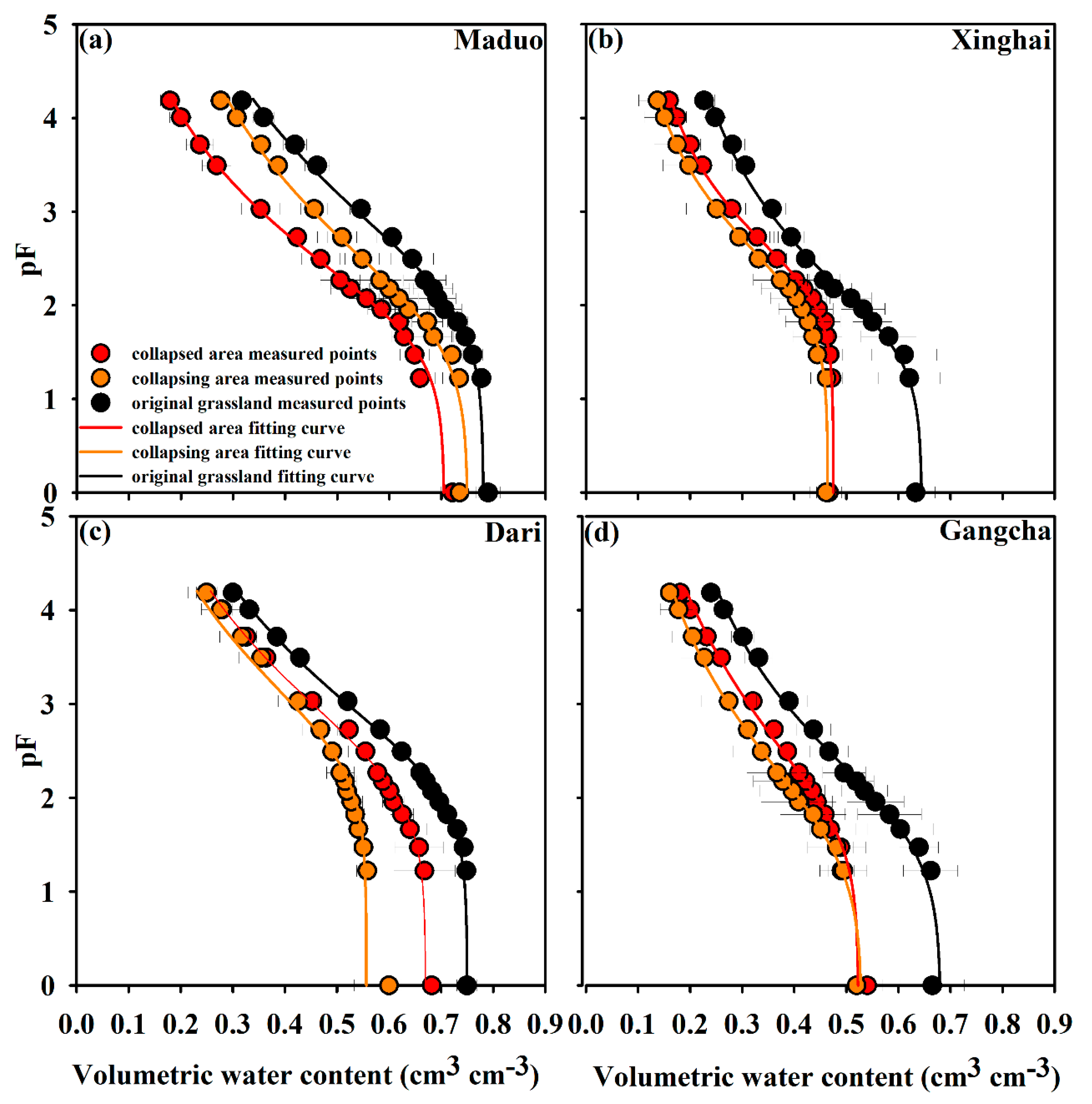
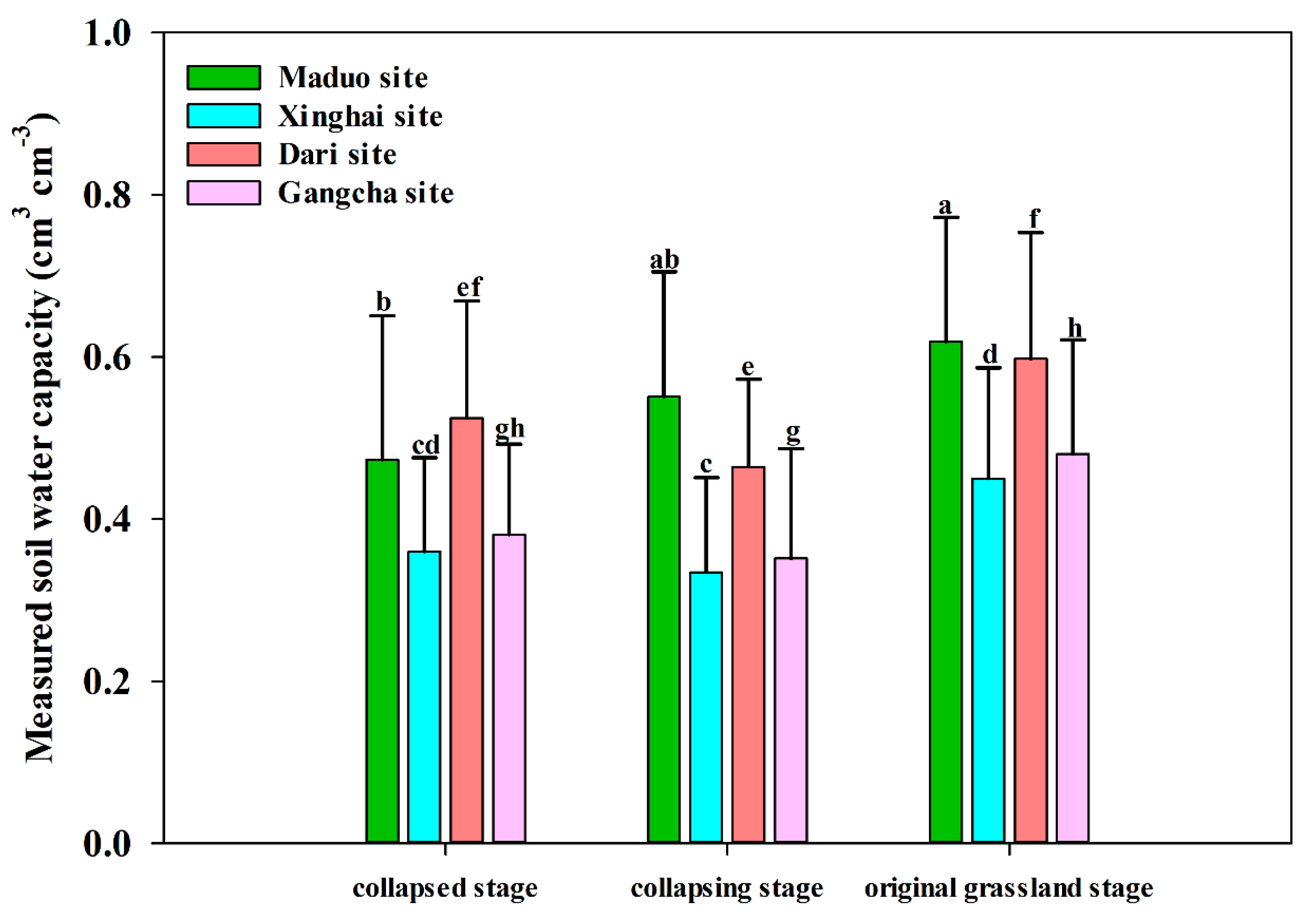
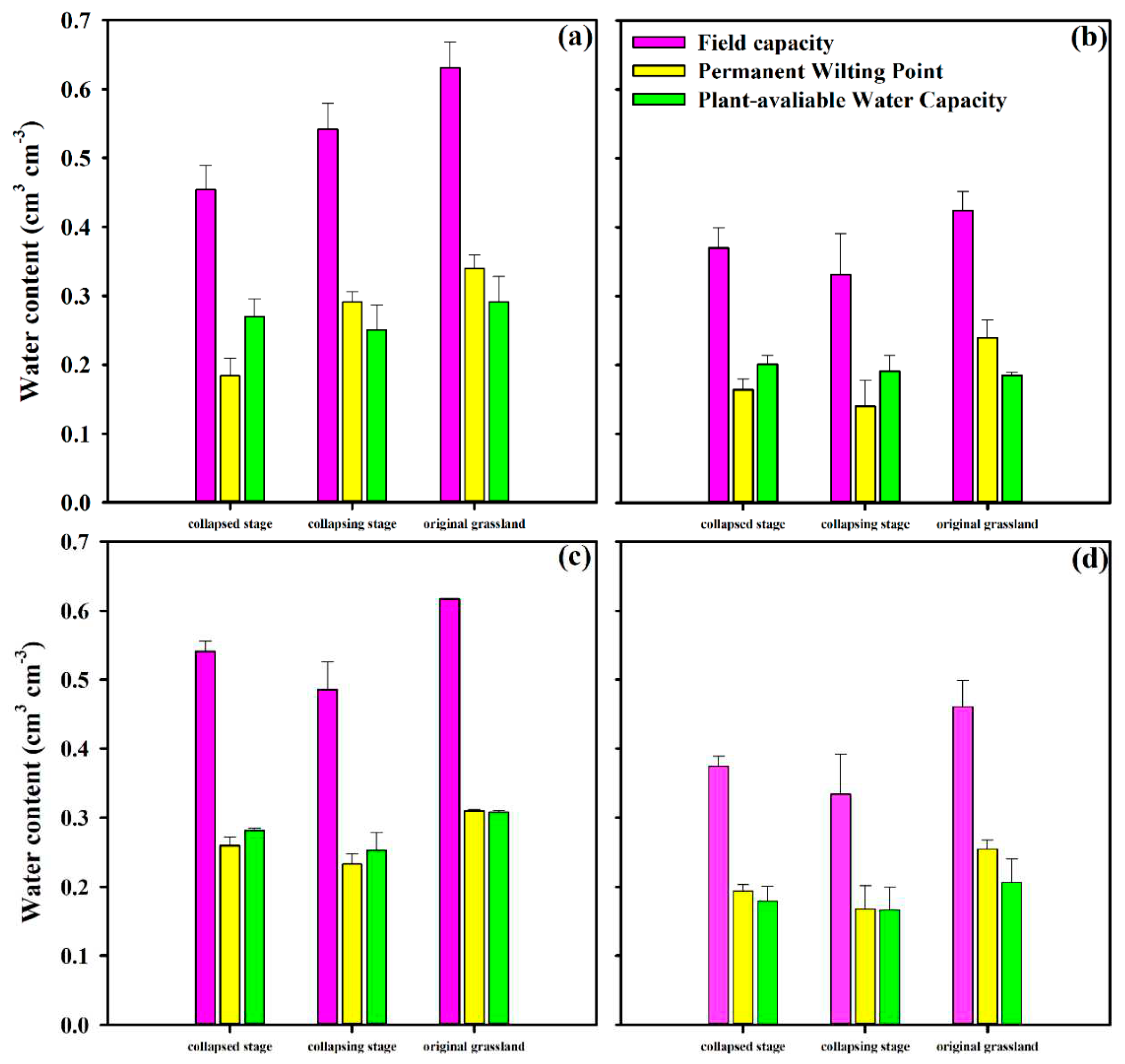
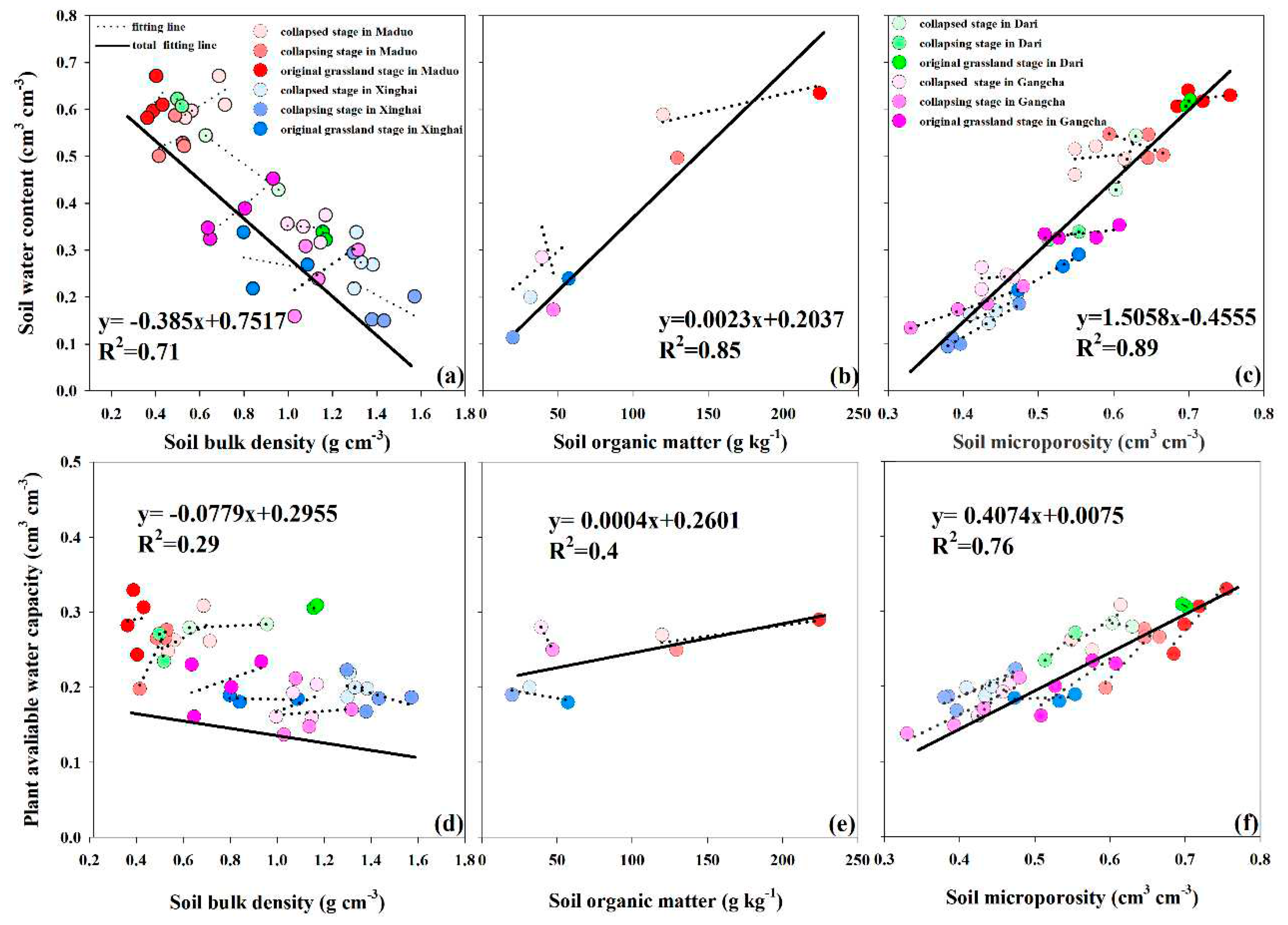
| Study Site | Latitude | Longitude | Elevation (m) | Mean Annual Air Temperature (°C) |
Highest Temperature (°C) | Lowest Temperature (°C) | Annual Precipitation (mm) |
|---|---|---|---|---|---|---|---|
| Maduo | 34°29′ N | 98°02′ E | 4355 | -1.45 | 8.8 | -13.8 | 92 |
| Xinghai | 35°49′ N | 99°55′ E | 3900 | 0.55 | 11.5 | -11.9 | 87 |
| Dari | 34°08′ N | 99°28′ E | 4329 | -3.3 | 8.1 | -14.9 | 942 |
| Gangcha | 37°53′ N | 98°25′ E | 3515 | -6.2 | 6.6 | -18.9 | 313 |
| Site of freeze thaw slump | Stages of freeze thaw slump | Soil water content (cm3 cm-3) | Soil bulk density (g cm-3) |
Soil organic matter (g kg-1) |
|
|---|---|---|---|---|---|
| Maduo | Collapsed stage | 0.5 | 0.62 | 119.87 | |
| Collapsing stage | 0.52 | 0.49 | 129.52 | ||
| Original grassland stage | 0.62 | 0.4 | 224.23 | ||
| Xinghai | Collapsed stage | 0.17 | 1.33 | 31.72 | |
| Collapsing stage | 0.12 | 1.42 | 19.84 | ||
| Original grassland stage | 0.26 | 0.91 | 57.15 | ||
| Dari | Collapsed stage | 0.49 | 0.79 | N/A | |
| Collapsing stage | 0.33 | 1.16 | N/A | ||
| Original grassland stage | 0.61 | 0.66 | N/A | ||
| Gangcha | Collapsed stage | 0.24 | 1.1 | 39.24 | |
| Collapsing stage | 0.19 | 1.14 | 46.89 | ||
| Original grassland stage | 0.34 | 0.75 | N/A | ||
| Sites of freeze thaw collapse | States of thaw slump | Fitting parameters of SWRCs | Model Performance | ||||
|---|---|---|---|---|---|---|---|
| θr (cm3 cm-3) | θs (cm3 cm-3) | α(°) | n | RMSE(cm3 cm-3) | R2 | ||
| Maduo | collapsed stage | 0.00±0.00 | 0.71±0.02 | 0.02±0.01 | 1.25±0.03 | 0.012 | 0.995 |
| collapsing stage | 0.07±0.07 | 0.75±0.04 | 0.02±0.02 | 1.22±0.03 | 0.011 | 0.993 | |
| original stage | 0.00±0.00 | 0.78±0.02 | 0.01±0.01 | 1.17±0.02 | 0.013 | 0.992 | |
| Xinghai | collapsed stage | 0.10±0.02 | 0.48±0.03 | 0.01±0.00 | 1.42±0.08 | 0.005 | 0.998 |
| collapsing stage | 0.07±0.04 | 0.46±0.03 | 0.01±0.00 | 1.37±0.08 | 0.005 | 0.998 | |
| original stage | 0.13±0.10 | 0.65±0.05 | 0.02±0.01 | 1.28±0.10 | 0.010 | 0.994 | |
| Dari | collapsed stage | 0.00±0.00 | 0.67±0.06 | 0.01±0.01 | 1.21±0.01 | 0.009 | 0.996 |
| collapsing stage | 0.00±0.00 | 0.56±0.02 | 0.00±0.00 | 1.23±0.03 | 0.004 | 0.999 | |
| original stage | 0.00±0.00 | 0.75±0.01 | 0.01±0.00 | 1.20±0.00 | 0.006 | 0.998 | |
| Gangcha | collapsed stage | 0.01±0.02 | 0.52±0.03 | 0.02±0.01 | 1.18±0.04 | 0.012 | 0.985 |
| collapsing stage | 0.04±0.04 | 0.53±0.04 | 0.04±0.04 | 1.23±0.06 | 0.007 | 0.994 | |
| original stage | 0.09±0.10 | 0.68±0.06 | 0.03±0.03 | 1.26±0.13 | 0.013 | 0.990 | |
| Sites of freeze thaw collapse | States of thaw slump | SWS (mm) | PAWS (mm) | PAW(mm) |
|---|---|---|---|---|
| Total | Total | Total | ||
| Maduo | collapsed stage | 12.4 | 4.96 | 0.16 |
| collapsing stage | 12.74 | 5.63 | 0.23 | |
| originalgrassland stage | 15.5 | 8.8 | 0.44 | |
| Xinghai | collapsed stage | 11.83 | 0.40 | 0.01 |
| collapsing stage | 8.52 | 0.00 | 0.00 | |
| originalgrassland stage | 11.31 | 0.94 | 0.02 | |
| Dari | collapsed stage | 15.56 | 9.09 | 0.23 |
| collapsing stage | 19.14 | 5.8 | 0.10 | |
| originalgrassland stage | 19.36 | 7.65 | 0.30 | |
| Gangcha | collapsed stage | 12.38 | 2.73 | 0.05 |
| collapsing stage | 10.26 | 0.57 | 0.01 | |
| originalgrassland stage | 13.08 | 3.00 | 0.08 |
| Sites of freeze thaw collapse | States of thaw slump | Porosity (cm3 cm-3) | |||
|---|---|---|---|---|---|
| Microporosity (< 30 μm) |
Mesoporosity (30-100μm) |
Macroporosity (>100μm) |
|||
| Maduo | collapsed stage | 0.57±0.03 | 0.08±0.02 | 0.05±0.02 | |
| collapsing stage | 0.64±0.03 | 0.07±0.03 | 0.05±0.04 | ||
| original grassland stage | 0.72±0.03 | 0.04±0.01 | 0.02±0.01 | ||
| Xinghai | collapsed stage | 0.44±0.03 | 0.03±0.01 | 0.01±0.00 | |
| collapsing stage | 0.41±0.04 | 0.04±0.02 | 0.02±0.01 | ||
| original grassland stage | 0.52±0.04 | 0.08±0.01 | 0.05±0.01 | ||
| Dari | collapsed stage | 0.62±0.02 | 0.04±0.03 | 0.02±0.02 | |
| collapsing stage | 0.53±0.00 | 0.02±0.01 | 0.01±0.00 | ||
| original grassland stage | 0.70±0.00 | 0.04±0.01 | 0.02±0.00 | ||
| Gangcha | collapsed stage | 0.44±0.02 | 0.05±0.09 | 0.03±0.01 | |
| collapsing stage | 0.41±0.06 | 0.06±0.02 | 0.06±0.05 | ||
| Original grassland stage | 0.56±0.05 | 0.07±0.03 | 0.06±0.05 | ||
| Thaw slump stages | Soil layer (cm) | Soil type | Vegetation | Particle size composition | ||
|---|---|---|---|---|---|---|
| Clay (%) | Silt (%) | Sand (%) | ||||
| Original grassland | 0-10 | Subalpine meadow soil | Kobresia Pygmaea | 6.13 | 46.18 | 47.68 |
| Collapsing areas | 0-10 | 4.28 | 43.42 | 52.30 | ||
| Collapsing areas | 0-10 | 3.48 | 36.43 | 60.09 | ||
Disclaimer/Publisher’s Note: The statements, opinions and data contained in all publications are solely those of the individual author(s) and contributor(s) and not of MDPI and/or the editor(s). MDPI and/or the editor(s) disclaim responsibility for any injury to people or property resulting from any ideas, methods, instructions or products referred to in the content. |
© 2023 by the authors. Licensee MDPI, Basel, Switzerland. This article is an open access article distributed under the terms and conditions of the Creative Commons Attribution (CC BY) license (http://creativecommons.org/licenses/by/4.0/).





